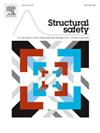结构安全中的概率解释--一个哲学难题
IF 6.3
1区 工程技术
Q1 ENGINEERING, CIVIL
引用次数: 0
摘要
概率这一术语在结构安全领域是必不可少的,但其解释,即使经过50多年的应用,仍然是一个讨论的主题。例如,在特定时期内属于同一队列的结构的失效概率,通常以纯频率论的方式理解为该时期和组合中可观察到的失效事件的平均数量。相比之下,贝叶斯解释认为概率是一种信念程度,是对决策者最佳信念或知识的信息状态的反映。在结构可靠性领域,根据决策问题的类型,概率通常被称为不确定性的名义(或名义)度量,以强调这些值取决于模型和可用的观测值。因此,概率方法主要用于根据模型、可用观察和其他相关信息,为不同可能结果或决定分配概率。本文讨论了这些解释的背景,以及可靠性计算和故障观测之间的对应程度可以预期和/或实现。与JCSS思路相对应的建议将在第8节中进行总结。本文章由计算机程序翻译,如有差异,请以英文原文为准。
Interpretation of probability in structural safety – A philosophical conundrum
The term probability is essential in the domain of structural safety and yet its interpretation is, even after more than 50 years of application, still a subject of discussion. For instance, the probability of failure of structures belonging to the same cohort for a specific period of time, is often understood in a pure frequentist way as an observable average number of failure events for that period and portfolio. By contrast, the Bayesian interpretation considers probability as a degree of belief and a reflection of the state of information to the best belief or knowledge of the decision maker. In the field of structural reliability, depending on the type of decision problem, probabilities are often referred to as nominal (or notional) measures of uncertainty to emphasize that these values are conditional on a model and available observations. Probabilistic methods then serve primarily to undertake the book-keeping required to assign probabilities to different possible outcomes or decisions in consistency with models, available observations and other relevant information. This paper discusses the background of these interpretations and the degree to which correspondence between reliability calculations and observations of failures can be expected and/or achieved. Recommendations corresponding to the JCSS line of thinking will be summarized in Section 8.
求助全文
通过发布文献求助,成功后即可免费获取论文全文。
去求助
来源期刊

Structural Safety
工程技术-工程:土木
CiteScore
11.30
自引率
8.60%
发文量
67
审稿时长
53 days
期刊介绍:
Structural Safety is an international journal devoted to integrated risk assessment for a wide range of constructed facilities such as buildings, bridges, earth structures, offshore facilities, dams, lifelines and nuclear structural systems. Its purpose is to foster communication about risk and reliability among technical disciplines involved in design and construction, and to enhance the use of risk management in the constructed environment
 求助内容:
求助内容: 应助结果提醒方式:
应助结果提醒方式:


